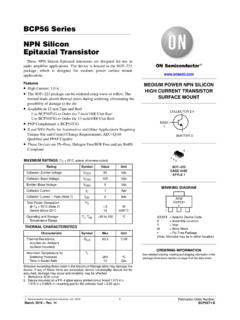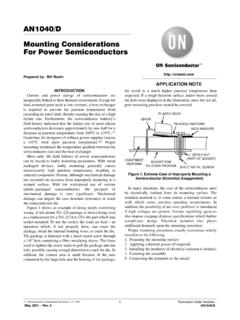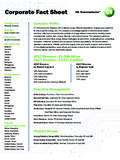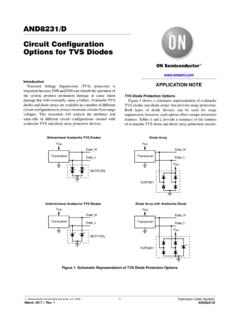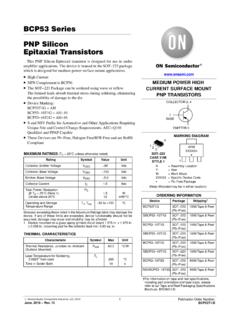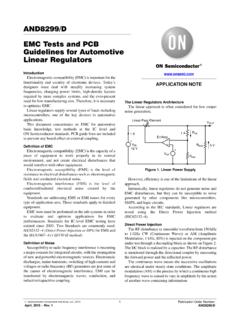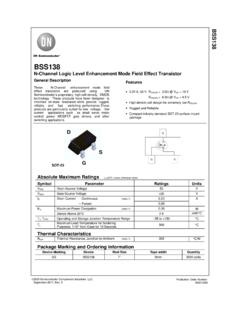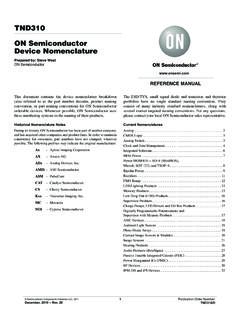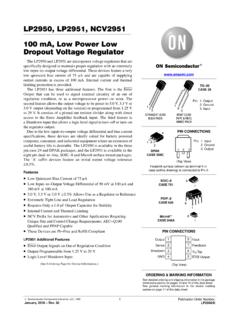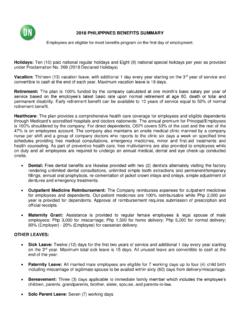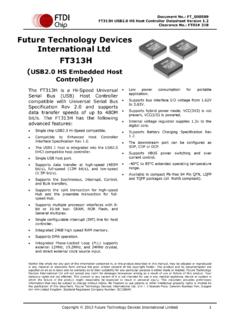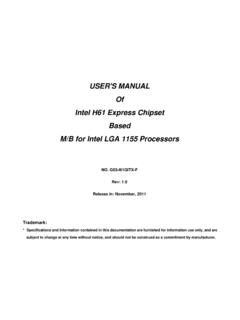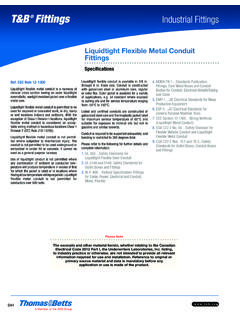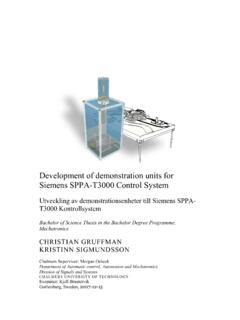Transcription of An Improved 2-Switch Forward Converter Application
1 An Improved 2-Switch Forward Converter ApplicationAgenda1. Generalities on Forward converters2. Core reset: tertiary winding, RCD clamp, 2-Switch forward3. Specs review of the NCP1252 s demo board4. Power components calculation 5. NCP1252 components calculation6. Closed-loop feedback: simulations and compensation7. Demo board schematics & Board performance review9. ConclusionsAgenda1. Generalities on Forward converters2. Core reset: tertiary winding, RCD clamp, 2-Switch forward3. Specs review of the NCP1252 s demo board4. Power components calculation 5. NCP1252 components calculation6. Closed-loop feedback: simulations and compensation7.
2 Demo board schematics & Board performance review9. ConclusionsGeneralities About the 1-Switch Forward ConverterPROs It is a transformer-isolated buck-derived topology It requires a single transistor, ground referenced Non-pulsating output current reduces rms content in the capsCONs Smaller power capability than a full or half-bridge topology Limited in duty-cycle (duty ratio) excursion because of core reset The drain voltage swings to twice the input voltage or moreAgenda1. Generalities on Forward converters2. Core reset: tertiary winding, RCD clamp, 2-Switch forward3. Specs review of the NCP1252 s demo board4.
3 Power components calculation 5. NCP1252 components calculation6. Closed-loop feedback: simulations and compensation7. Demo board schematics & Board performance review9. ConclusionsD1D2 CRQ1 Vin0 LmagLX1 Transformer Core Reset: Why?Q1 ILmag Without transformer core reset:tt The current builds up at each switching cycle It brings the core into saturationCRD2D1Q1 VinLmagL0X1D3 Transformer Core Reset: Why? With transformer core reset:tt The current does not build up at each switching cycle Volt-seconds average to zero during each cycle The voltage reverses over Lmagand resets itQ1 ILmagCore Reset Techniques: How ? Energy is stored in the magnetizing inductor This energy does not participate to the power transfer It needs to be released to avoid flux walk away 3 common standard techniques for the core reset:9 Tertiary winding9 RCD clamp92-switch forwardCore Reset Techniques: Tertiary WindingCRD2D1Q1 VinLmagL0X1D3 Reset with the 3rdwinding Duty ratio can be > 50%But/Q1peak voltage can be > 2 Vin/3rdwinding for the transformer 3rdwindingCore Reset Techniques.
4 RCD ClampCRD2D1Q1 VinLmagL0X2 XFMR1 RclampCclampDclamp Reset with RCD clamp Duty ratio can be > 50%But/Writing equation and simulation are required for checking the correct reset /Lower cost than 3rdwinding techniqueRCD clampCRD2D1 VinQ1 LmagX1L0Q2D4D3 Core Reset Techniques: 2-Switch Forward Reset with a 2-Switch Forward Easy to implement Q1peak voltage is equal to VinBut/Additional power MOSFET (Q2) + high side driver/2 High voltage, low power diodes (D3& D4) 2-Switch Forward resetNote : Q1& Q2have same drive command2-Switch Forward : How Does It Works?CRD2D1 VinQ1 LmagX1L0Q2D4D3 OFFONOFFOFFStep 3 ONONOFFOFFStep 2 OFFOFFONONStep 1D3& D4D2D1Q1& Q2 ILmagILStep 1 Step 2 Step 3 Note : Primary controller status on time : Step1 off time : Step 2 + Step 3ttAgenda1.
5 Generalities on Forward converters2. Core reset: tertiary winding, RCD clamp, 2-Switch forward3. Specs review of the NCP1252 s demo board4. Power components calculation 5. NCP1252 components calculation6. Closed-loop feedback: simulations and compensation7. Demo board schematics & Board performance review9. ConclusionsUnique FeaturesBenefitsValue PropositionMain differences with the UC384X series14 CCPG Jun-09 The NCP1252 offers everything needed to build a cost-effective and reliable ac-dc switching power supply. Adjustable soft start duration Internal ramp compensation Auto-recovery brown-out detection Vcc up to 28 V with auto-recovery UVLO Frequency jittering 5% of the switching frequency Duty cycle 50% with A Version, 80% with B versionOthers FeaturesOrdering & Package InformationMarket & ApplicationsNCP1252 Fixed Frequency Controller Featuring Skip Cycle and Latch OCP ATX Power supply AC adapters NCP1252 ADR2G: 50% Duty Cycle SOIC8 NCP1252 BDR2G: 80% Duty Cycle SOIC8 Adjustable switching freq.
6 Delayed operation upon startup Latched Short circuit protection timer based. skip cycle mode Design flexibility independent of the aux. winding Allow temporary over load and latch permanent fault Achieve real no load operationYesNo5 V voltage start No120 msDelay on startup NoLatch-off, 15 ms delayPre-short protection NoYesBrown-Out with shutdown featureNoYesSkip Cycle (light load behavior)No300 Hz, 5%Frequency jittering Ramp CompensationNoYesLeading Edge Blanking (LEB)500 A< 100 AStartup currentUC3843/5 NCP1252UC3843/5 Application ExempleBOPre-short protectionSSDelay upon startupUC3843/5 UC384X does not include brown-out, soft-start and overload detection the external implementation cost of these functions is $ NCP1252 includes them all, reducing cost and improving reliabilitySpec Review: NCP1252 s Demo Board Input voltage range: 340-410 V dc Output voltage: 12 V dc, 5% Nominal output power: 96 W(8 A) Maximal output power: 120 W(5 seconds per minute) Minimal output power: real no load(no dummy load!)
7 Output ripple : 50 mV peak to peak Maximum transient load step: 50% of the max load Maximum output drop voltage: 250 mV(from Iout = 50% to Full load (5 A 10 A) in 5 s)Agenda1. Generalities on Forward converters2. Core reset: tertiary winding, RCD clamp, 2-Switch forward3. Specs review of the NCP1252 s demo board4. Power components calculation 5. NCP1252 components calculation6. Closed-loop feedback: simulations and compensation7. Demo board schematics & Board performance review9. ConclusionsPower Components Calculation: Transformer (1/3) Step 1: Turns ratio calculation in CCM:120 9 350 0 450085outbulk minmaxoutbulk = = = =Where: Voutis the output voltage isthe targeted efficiency Vbulkminis the min.
8 Input voltage DCmaxis the max duty cycle of the NCP1252 N is the transformer turn ratioPower Components Calculation: Transformer (2/3) Step 2: Verification: Maximum duty cycle at high input line DCmin(Based on the previous equation)1209 410 008538 2outbulk maxminoutminbulk % = = = =Where: Voutis the output voltage isthe targeted efficiency Vbulkmaxis the max. input voltage N is the transformer turn ratioPower Components Calculation: Transformer (3/3) Step 3: Magnetizing inductor value. For resetting properly the core, a minimal magnetizing current is needed to reverse the voltage across the winding. (Enough energy must be stored so to charge the capacitance) Rule of thumb: Magnetizing current = 10% primary peak current( ILmag_pk= 10% Ip_pk)ILmagIptt35013 4 mH1001 094045125bulk _ minmagp_ DCminTswPower Components Calculation: LC Output Filter (1/4) Step 1: Crossover frequency (fc) selection arbitrarily selected to 10 kHz.
9 Fc> 10 kHz requires noiseless layout due to switching noise (difficult). Crossover at higher frequency is not recommended Step 2: Cout& RESR estimation If we consider a Vout= 250 mV dictated by fc, Cout& Iout, we can write the following equation:ESR5318 318 outoutoutcoutESRcoutICCfVRmfC Where: fccrossover frequency Ioutis the max. step load current Voutis the max. drop voltage @ IoutPower Components Calculation: LC Output Filter (2/4) Step 3: Capacitor selection dictated by ESR rather than capacitor value: Selection of 2x1000 F, FM capacitor type @ 16 V from Panasonic. Extracted from the capacitor spec: Ic,rms= A (2* A) @ TA= +105 C RESR,low= m (19 m /2) @ TA= +20 C RESR,high= m (57 m /2) @ TA= -10 C Voutcalculation @ Iout= 5 A 5285 142mVoutoutESR , = = =Is acceptable given a specification at 250 mVTips: Rule of thumb: 22 ESR ,highESR( step )R Power Components Calculation: LC Output Filter (3/4) Step 4: Maximum peak to peak output current50227A22rippleLESR , RESR,max= 22 m @ 0 C Step 5: Inductor value calculation()()()11211103822712526 HoutLminswoutminswLVIDCTLVLDCT.
10 = ILDCminTsw(1-DCmin)Tsw ILt Let select a standardized value of 27 HPower Components Calculation: LC Output Filter (4/4) Step 6: rms current in the output capacitorL11038101 06 A1212 2 81327where2 81312 1110 125outminC, .VkIF == = ===Note: Lis the normalized inductor time constantICout,rms( A) < IC,rms( A) No need to adjust or change the output capacitorsPower Components Calculation: Transformer Current RMS current on primary and secondary side secondary currents: Primary current can calculated by multiplying the secondary current with the turns ratio:IL ILtIL_pkIL_valleyIpDCTsw(1-DC)Tswt227101 1 13 A2211 13 2 278 86 ALL_ pkoutL_valleyL_ =+ =+ == = =()()()2211 13 0 0850 95 A8 86 0 0850 75 A10100 63 A3p_ pkL_ pkp _ valleyL _ valleyLp ,rmsmaxp _ pkp _.
